
Nasir al-Din Muhammad, commonly known by his regnal name Humayun, was the second Mughal emperor, who ruled over territory in what is now Eastern Afghanistan, Bangladesh, Northern India, and Pakistan from 1530 to 1540 and again from 1555 to his death in 1556. At the time of his death, the Mughal Empire spanned almost one million square kilometers.

Mir Qamar-ud-din Khan Siddiqi also known as Chin Qilich Qamaruddin Khan, Nizam-ul-Mulk, Asaf Jah and Nizam I, was the first Nizam of Hyderabad.

Dara Shikoh, also transliterated as Dara Shukoh, was the eldest son and heir-apparent of the Mughal emperor Shah Jahan. Dara was designated with the title Padshahzada-i-Buzurg Martaba and was favoured as a successor by his father and his elder sister, Princess Jahanara Begum. He had been given the title of 'Shah-e-Buland Iqbal' by Shah Jahan. In the war of succession which ensued after Shah Jahan's illness in 1657, Dara was defeated by his younger brother Prince Muhiuddin. He was executed in 1659 on Aurangzeb's orders in a bitter struggle for the imperial throne.
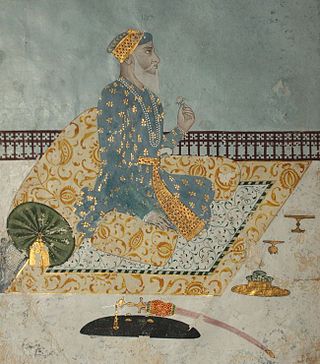
Saadat Khan Nishapuri was the first Nawab of Kingdom of Awadh from 26 January 1722 to 1739 and the son of Muhammad Nasir. At age 25, he accompanied his father on the final campaign of the Mughal Emperor Aurangzeb against the Marathas in the Deccan, and the emperor awarded him the title of Khan Bahadur for his service.
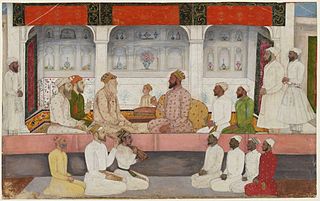
The Sayyid brothers were Syed Hassan Ali Khan Barha and Syed Hussain Ali Khan, two powerful Mughal nobles during the decline of the empire.

Ali Mardan Khan was a Kurdish military leader and administrator, serving under the Safavid kings Shah Abbas I and Shah Safi, and later the Mughal ruler Shah Jahan. He was the son of Ganj Ali Khan. After surrendering the city of Qandahar, part of the easternmost territories of the Safavids to the Mughals in 1638, he served with distinction in the Mughal administration, earning the highest honors of the Mughal court.
Shaikh Gadai Kamboh was a Punjabi Muslim Sufi saint. He was the son, disciple and successor of famous scholar, philosopher and poet-laureate Shaikh Jamali Kamboh of Delhi and brother of the 'Master of Expression' —Shaikh Abd-al-Hai Hayati. His real name was Abdur Rehman but he became famous as Gadai. He was well-renowned for his sanctity and learning and was in high favour with emperor Humayun and Bairam Khan. He is also said to have remained a Musahib of the Afghan emperor Salim Shah Suri. During Akbar’s reign, he occupied the high office of “Sadr-i-sadur” of Hindustan.

The Mughal Empire was an early modern empire in South Asia. At its peak, the empire stretched from the outer fringes of the Indus River Basin in the west, northern Afghanistan in the northwest, and Kashmir in the north, to the highlands of present-day Assam and Bangladesh in the east, and the uplands of the Deccan Plateau in South India.
The Mughal–Safavid war of 1649–1653 was fought between the Mughal and Safavid empires in the territory of modern Afghanistan. While the Mughals were at war with the Janid Uzbeks, the Safavid army captured the fortress city of Kandahar and other strategic cities that controlled the region. The Mughals attempted to regain the city, but their efforts were proven unsuccessful.

Mian Muhammad Amin Khan Turani , was a Mughal noble of Central Asian origin. He served as sadr-us-sudur during the reign of Mughal emperor Aurangzeb, and briefly occupied the post of wazir during the reign of Muhammad Shah. He was the uncle of Chin Qilich Khan, the first Nizam of Hyderabad.

The Mughal–Persian wars were a series of wars fought in the 16th, 17th and 18th centuries between the Safavid and Afsharid Empires of Persia, and the Mughal Empire of India, over what is now Afghanistan. The Mughals consolidated their control of what is today India and Pakistan in the 16th century, and gradually came into conflict with the powerful Safavids and Afsharids, led by Abbas the Great and Nader Shah respectively. Aside from Nader Shah's invasion of the Mughal Empire, most of the conflict between the two powers were limited to battles for control over Kandahar. From a Safavid point of view, the Mughal army counted as "far less formidable" than that of their arch rivals the Ottomans.
Kandahari Begum was the first wife of the Mughal emperor Shah Jahan and the mother of his first child, Princess Parhez Banu Begum.
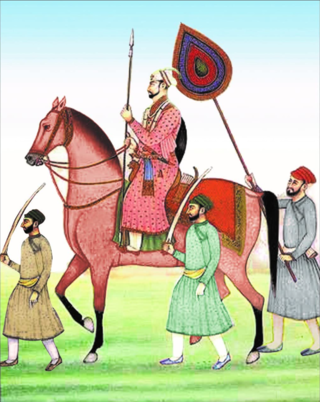
Khan Dowran VII, was a Mughal statesman and general in the eighteenth century. Originally Khwaja Asim, he was made Samsam ud-Daula Khan-i Dauran and was the Mir Bakshi and Amir-ul-Umara. He was the head of all the imperial nobility and the commander-in-chief of the Mughal army during the reign of Muhammad Shah, and served the Emperor until his death at the Battle of Karnal.
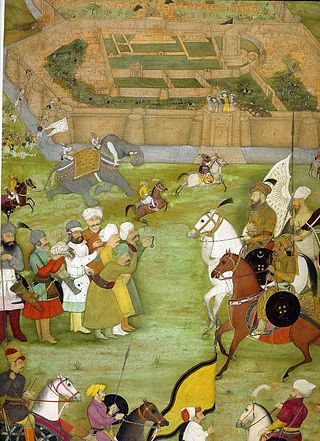
The foreign relations of the Mughal Empire were characterized by competition with the Persian Empire to the west, the Marathas and others to the south, and the British to the east. Steps were taken by successive Mughal rulers to secure the western frontiers of India. The Khyber Pass along the Kabul- Qandahar route was the natural defence for India, and their foreign policy revolved around securing these outposts, as also balancing the rise of powerful empires in the region.

Roshan-ud-Daulah, known by his original name Khwaja Muzaffar Panipati and the title of Turra-i-Baz Roshan-ud-Daulah Zafar Khan, was the Grand Vizier of the Mughal Empire during the reign of Muhammad Shah. He was known by the nickname Turra-i-Baz(falcon's crest) as Roshan-ud-Daula and all his men wore their turbans in the same way, with an end sticking out.
The Ansaris of Panipat are descended from Khwaja Abdullah Pir of Herat, one of whose descendants settled in Panipat, which was a centre of learning and was already famous for its Mashaikh and Auliya.
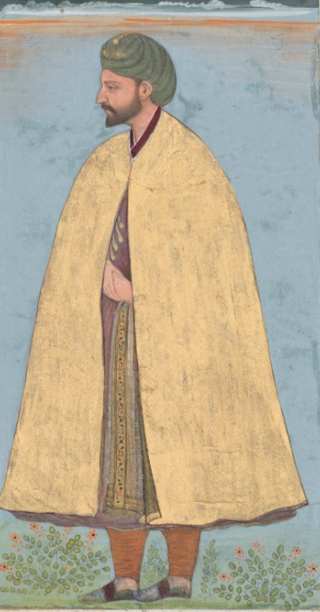
Najib al-Din Humayun, commonly known as Hakim Humam or Hakim Hamam, was a physician (hakim) and an official in the service of the Mughal emperor Akbar. A native of Gilan in present-day Iran, he migrated to present-day India with his brothers to escape Safavid persecution. He held several positions in Akbar's service, and served as the Mughal ambassador to Abdullah Khan II of Bukhara.

Shah Tahmasp of Persia tried to exploit the inexperience of the young Mughal Emperor Akbar, then an adolescent. He sent an army to lay siege to Kandahar, a vital southern Afghan city held by Shah Muhammad, a governor appointed by the Mughal regent Bairam Khan. With no way to offer military assistance, Akbar was compelled to surrender Kandahar to the Persians. The Persians held the city on and off for almost four decades before the Mughals recovered it.
















